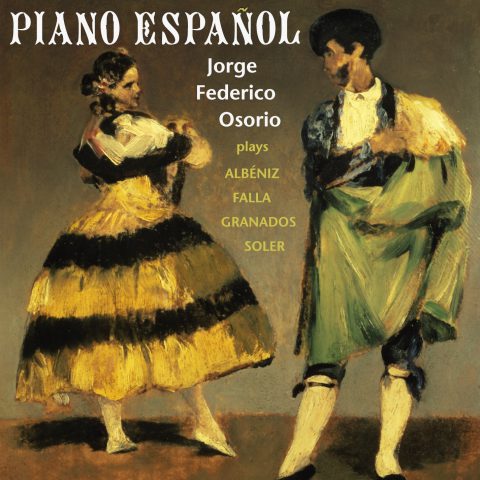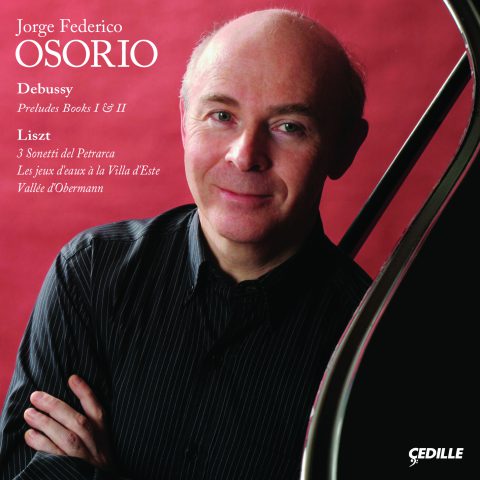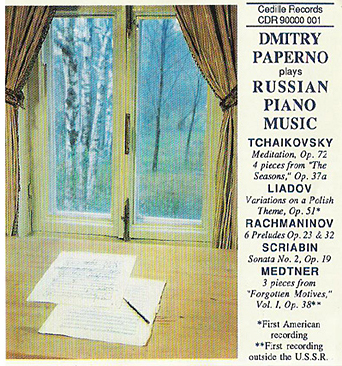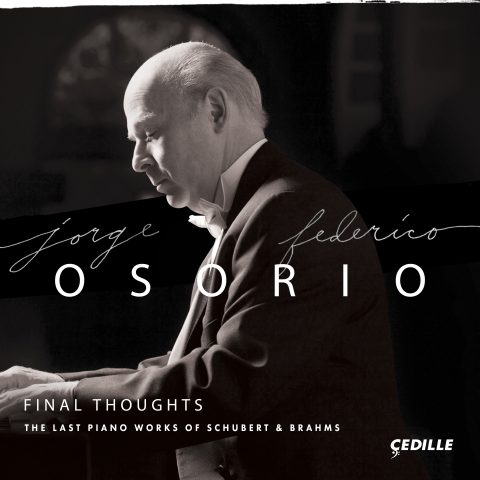Store
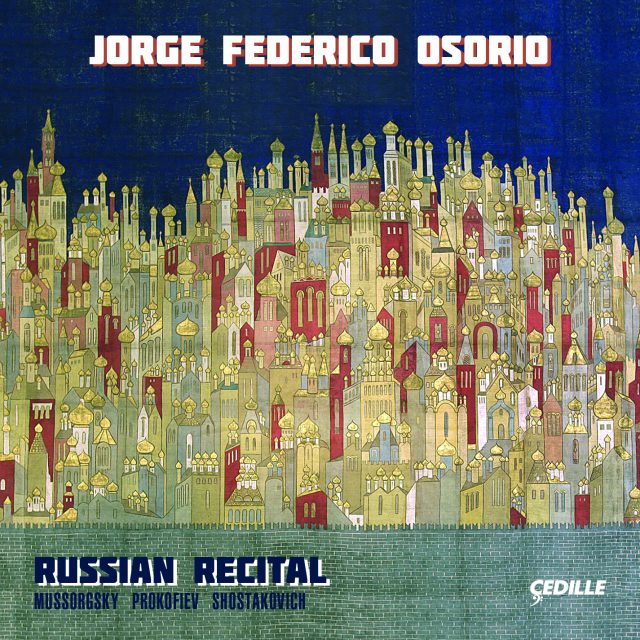
Internationally admired concert pianist Jorge Federico Osorio, praised by The New York Times for “the sweep and freshness of his readings,” offers a riveting and richly pictorial recital on his first-ever recording of Russian masterworks for solo piano. Mussorgsky’s original piano setting of his popular Pictures at an Exhibition anchors an absorbing program that includes Prokofiev’s Sixth Sonata and Romeo and Juliet Before Parting, plus Shostakovich’s Prelude and Fugue No. 24 in D minor.
Preview Excerpts
SERGEI PROKOFIEV (1891–1953)
Piano Sonata No. 6 in A major, Op. 82
PROKOFIEV
from Ten Pieces from Romeo and Juliet, Op. 75
DMITRI SHOSTAKOVICH (1906–1975)
Prelude and Fugue No. 24 in D minor from 24 Preludes and Fugues, Op. 87
MODEST MUSSORGSKY (1839–1881)
Pictures at an Exhibition
Artists
Program Notes
Download Album BookletRussian Recital
Notes by Andrea Lamoreaux
As orchestrated by Maurice Ravel, Modest Mussorgsky’s Pictures at an Exhibition is in the repertory of virtually every orchestra in the world and has been recorded, often multiple times, by at least half of them. The undeniable vigor and brilliance of Ravel’s version has tended to obscure the fact that Mussorgsky intended the work as a pictorial suite for piano. It’s a highly original work in its strong linkages between the sounds of the keyboard and the vivid images that inspired them.
Pictures at an Exhibition was inspired by the death of Mussorgsky’s friend Viktor Hartmann in 1873. The following year in St. Petersburg, there was a memorial exhibition of the works of this painter/architect/stage designer, and Mussorgsky’s attendance at this exhibit produced two memorial compositions: this piano suite, and the Songs and Dances of Death for bass voice and orchestra.
It’s interesting to observe a difference between Pictures at an Exhibition and Debussy’s Preludes, which also evoke a number of pictorial images, including a sunken cathedral, fog, and Dickens’s Mr. Pickwick (and which Jorge Federico Osorio recorded on Cedille Records CDR 90000 098). But Debussy appended his descriptive titles only after he’d written the music, and while they may remain in our thoughts as we listen, we don’t always need them to appreciate the sounds. Mussorgsky’s “Pictures,” by contrast were directly inspired by specific works of art, and his intention was to re-create these visual images in sonic terms. He succeeded brilliantly, whether we hear the suite in its original piano version, or Ravel’s orchestration, or the orchestrations by so many others.
The suite is unified by its use of a passage called Promenade, which is the opening movement and which recurs at intervals throughout the piece. It’s also the source of several motives for the other movements. In the Promenade we hear and envision Mussorgsky walking around the exhibit hall, perhaps humming to himself. The tune is laid out in irregular meters, so we’re not marching through the galleries, we’re just strolling.
The Promenade gets us under way.
Gnomus is Hartmann’s design for a children’s toy, perhaps a wooden nutcracker, the figure a humorous caricature of a gnome or elf.
[Promenade]
The Old Castle depicts a watercolor in which we see a castle and a singing medieval troubadour. This movement evokes the gently rocking rhythm of a barcarolle.
[Promenade]
Tuileries: a kind of scherzo with children romping in a famous Parisian park.
Bydlo presents a very different sound world. This picture portrays a Polish farm wagon drawn by oxen that plod along as the heavy wheels drag through thick mud.
[Promenade]
The Ballet of the Chicks in Their Shells is another scherzo-like interlude, inspired by Hartmann’s drawings of costumes for a ballet. The chicks dance playfully for about a minute, chirping all the while.
Once again the mood shifts as we visit a Jewish ghetto somewhere in Poland; the characters in this sharply-etched dialogue are a rich merchant, Samuel Goldenberg, and his poverty-stricken companion, Schmuyle.
[Promenade]
From Poland we return to France, for The Market-Place in Limoges, A third scherzo, this depicts not children or chicks but bustling women selling their wares at the famers’ market.
Catacombs and With the Dead in A Dead Language are inspired by Hartmann’s self-portrait against the backdrop of the underground catacombs of Paris. In the second portion, the motives of the Promenade are echoed, this time mournfully.
We are back in Russia for The Hut on Fowl’s Legs. This was inspired by Hartmann’s design for a clock, showing the fanciful home of the Russian witch named Baba-Yaga.
To conclude, Mussorgsky gives us his re-creation of one of Hartmann’s architectural drawings, the full title of which is The Heroes’ Gate in the Imperial City of Kiev. Usually shortened to The Great Gate of Kiev, this towering structure was never actually built. To represent it, Mussorgsky uses powerful repeated chords and heavy octave progressions that proceed to a mighty climax. Incorporating once again the theme of the unifying Promenade, he evokes not only the gigantic structure of the gate itself but also the sound of bells pealing out in triumph.
Prokofiev’s Sixth Sonata and Dmitri Shostakovich’s D Minor Prelude and Fugue, by contrast, are completely pianistic — even if the chord structures in the first movement of the sonata and the fugue’s massive ending could be construed as implications of orchestral sonority. Both these outstanding composers were also outstanding pianists, and the instrument is prominent on both of their work-lists.
Winter 1945: Roosevelt, Churchill, and Stalin at the Yalta Conference; the Battle of the Bulge in Western Europe; Soviet forces moving westward toward Berlin. In January of that year Prokofiev took the podium at the Moscow Conservatory to conduct the first performance of his Symphony No. 5, in which one can almost hear artillery fire and sense both the war’s frenzy and its fears. Audience members later recalled that they could hear actual gunfire during the performance: celebration of the news of an important Soviet Army advance.
Closely contemporaneous with the Symphony No. 5 are three piano sonatas that likewise convey belligerence in their aggressive dissonances and strong emotions; hence these works have come to be known as Prokofiev’s War Sonatas: Numbers 6, 7, and 8 in his piano-sonata catalogue.
Earlier works than the Fifth Symphony, the sonatas date from 1939 and 1940, a time when the composer was beleaguered with troubles. His marriage was in jeopardy because of his love for another woman; a friend and close collaborator was inexplicably arrested, and disappeared. He’d also been asked to write an homage to Josef Stalin, a superficially upbeat cantata known in English as “Hail to Stalin.” According to a Prokofiev biographer, Daniel Jaffe, the composer then “expressed his true feelings” with the sonatas. Since two of them later won Stalin Prizes, it would seem the Soviet music czars didn’t listen very perceptively.
“Brutal” is a word often used to describe the harmonies and textures of the War Sonatas. Certainly they are forceful — at one point in the Allegro moderato first movement of No. 6, the performer is directed to punch the keyboard with his fist. But brutality is not the intention. “Implacable” might best describe this movement’s sense of inevitable forward propulsion, its mood and themes dominated by the assertive opening rhythmic motive. The almost ceaseless energy and drama are occasionally interspersed with quieter moments, but the overall sense is one of demonic power.
Prokofiev cast his Sonata No. 6 in four movements, mimicking the structure of some of Beethoven’s big sonatas, and he uses this expanded layout to convey a wide range of moods and emotions. In the Allegretto second movement, a kind of scherzo, the mood is almost light-hearted compared to the Allegro, but here a sense of discontent creeps in due to the wandering tonal centers. More straightforward is the Tempo di valzer lentissimo (very slow) that has a soft dynamic throughout. In this waltz, Prokofiev speaks frankly of human feelings and longings, reminding many listeners of his Romeo and Juliet ballet music. The sonata’s finale, Vivace, returns to the almost incessant percussiveness of the first movement, while also recalling some of its themes. The sardonic flavor of the composer’s early piano Sarcasms, Op. 17 is felt here in the movement’s towering chords and crashing dissonances that threaten to spin off into chaos.
Two works on this CD may be thought of as surprises, since they’re much better known in their symphonic incarnations. Serge Prokofiev completed his Romeo and Juliet ballet in 1935, but neither the Kirov Ballet, in what was then the city of Leningrad, nor Moscow’s Bolshoi Ballet, was willing or able to mount it at that time. To utilize the music and keep the project in the public eye, the composer constructed two orchestral suites — which remain among his most frequently played scores — and a somewhat lesser-known ten-part piano suite. (The ballet itself was premiered in the Czech city of Brno in 1938 and finally made it to the Kirov stage in 1940.)
“A theme is an elusive thing,” Prokofiev once remarked. Perhaps for that reason, he always kept notebooks with him to record any musical idea that might occur to him (think of Beethoven’s famous sketch-books). And like Handel, his predecessor by some 200 years, Prokofiev hated to waste a good tune. He returned to youthful pieces for sonatas subtitled “From Old Notebooks”; he re-used ballet music in chamber music; and he created orchestral suites from operas and ballets — suites that are more often heard than the original large-scale works. As noted before, the piano suite called Ten Pieces from Romeo and Juliet arose partly because of difficulties and delays in getting the complete ballet performed. The movements chosen for piano reproduction only vaguely follow the sequence of the ballet movements and the story. Instead, they’re a study in contrasts: the violence of the Montague-Capulet feud juxtaposed immediately with the gentleness of Friar Laurence, for example. Most of the movements — Minuet, Masks, Mercutio — are very short, but in the finale, “Romeo and Juliet Before Parting,” Prokofiev allows a more expansive statement. This final portion of the suite expresses all the tenderness and pathos of the star-crossed lovers. It shows Prokofiev as a composer capable of great lyricism and beauty; no more telling contrast to the powerful sixth Sonata could be imagined.
Shostakovich produced cycles of symphonies and string quartets, 15 each, that are among the major achievements of 20th-century classical composition. In them may be heard not only his brilliant creativity and compositional skill, but also a kind of history of his tortured, back-and-forth relationship with the Soviet system under which he spent his entire life — unlike Prokofiev, who left Russia in the wake of the 1917 Revolution and lived in the U.S. and France until returning home in the early Thirties. A rule of thumb in commentary on Shostakovich is that the symphonies represent the public composer while the quartets portray his inner life, and it’s a useful way to look at the works. Something that can be seen as a quintessentially personal and private project is the set of 24 Preludes and Fugues, Op. 87, that he worked in the early 1950s as a kind of homage to Bach.
Bach’s Well-Tempered Clavier is a cycle of preludes and fugues in all the major and minor keys that represents a towering achievement in the history of keyboard composition. Among his successors, Chopin wrote 24 Preludes in all the keys, but did not couple them with fugues. Debussy’s two sets of Preludes were never intended to follow any key progression; their intent was quite different. Shostakovich, who also wrote a set of 24 preludes without fugues, Op. 34, set out to follow the complete Bach model with his Op. 87. It’s been suggested that one inspiration for this set was a trip to Leipzig in 1950, for ceremonies and concerts honoring the 200th anniversary of Bach’s death. Another motivation might have been to challenge himself by creating music in perhaps the strictest form there is: the fugue. Still another was to write a major cycle that would not attract much official notice in the aftermath of the Soviet authorities’ public denunciation of his larger scale words (e.g., Eighth Symphony) in 1948.
While long regarded mainly as teaching compositions, Bach’s Well-Tempered Clavier preludes and fugues are also profoundly musical. Likewise, Shostakovich doesn’t limit himself to technical exercises; he created in his Op. 87 a masterly suite of musical vignettes that sometimes take Russian folk music as their inspiration, and which everywhere show the genius of his musical imagination.
To follow the circle of fifths of traditional Classical-Romantic harmony, you begin with C Major and proceed to its relative, A Minor, then onward to G Major, E Minor, and so on. You end with D Minor, the relative of F Major. Shostakovich’s Prelude and Fugue No. 24 in D Minor is thus the grand finale of the entire set. Both Bach and Shostakovich used a wide range of styles and forms for their preludes; their comparative freedom of structure contrasts strongly with the prescribed layout of the fugues. Shostakovich’s Prelude No. 24 is slow, stately, even majestic, with a subsidiary theme developed in left-hand octaves that will be transformed into the main subject (theme) of the ensuing four-voiced fugue. After these voices are introduced and combined, Shostakovich proceeds through several key changes and arrives at the rather remote key of A-flat, with a new fugal subject that’s eventually amalgamated with the original one for a striking and powerful conclusion.
Andrea Lamoreaux is Music Director of 98.7WFMT, Chicago’s Classical Experience.
Album Details
Total Time: 78:15
Recorded: June 23–25, 2014, Fay and Daniel Levin Performance Studio at 98.7 WFMT, Chicago, Steinway Piano, Piano Technician Charles Terr
Producer: James Ginsburg
Engineer: Bill Maylone
Publishers: PROKOFIEV Piano Sonata No. 6 in A major, Op. 82 ©1940 Sikorski, PROKOFIEV Romeo and Juliet Before Parting ©1960 Sikorski, SHOSTAKOVICH Prelude and Fugue No. 24 in D minor, Op. 87 ©1957 Sikorski
Cover Art: Natalja Goncharova, Backcloth for Diaghilev’s production of Stravinsky’s Firebird ©2014 Artists Rights Society (ARS), New York / ADAGP, Paris
Cover Design, Inside Booklet, and Inlay Card: Nancy Bieschke
© 2015 Cedille Records/Cedille Chicago
CDR 90000 153
